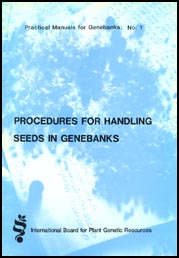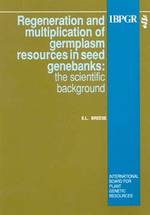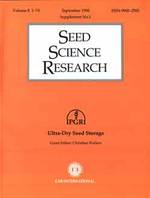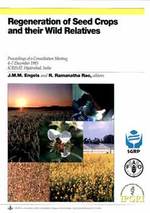Seed and seed genebanks
 |
Handbooks for Genebanks No. 1:
The Design of Seed Storage Facilities for Genetic Conservation (3.5 MB)
This is an in-depth report of the factors to be taken into consideration when designing seed storage facilities for genetic conservation. (Revised 1990).
Authors: Cromarty, A.S.; Ellis, R.H.; Roberts, E.H.
Publication Year: 1982
Pages: 100
Language: English
 |
Handbooks for Genebanks No. 2:
Handbook of Seed Technology for Genebanks Vol I: Principles and Methodology
This first volume of seed technology for genebanks deals with many of the principles of seed testing which need to be understood when monitoring the viability of seed accessions maintained in genebanks. It is the second in a general series of genebank handbooks. (Reprinted 1989)
Authors: Ellis, R.H.; Hong, T.D.; Roberts, E.H.
Publication Year: 1985
Pages: 210
ISBN-10: 92-9043-118-0
ISBN-13: 978-92-9043-118-3
Language: English
 |
Handbooks for Genebanks No. 3:
Handbook of Seed Technology for Genebanks Vol II: Compendium of Specific Germination Information and Test Recommendations
This second volume on seed technology for genebanks provides general approaches, detailed information, guidance and, when available, prescriptions for removing dormancy and germinating the seeds. It is the third in a general series of genebank handbooks. (Reprinted 1989)
Authors: Ellis, R.H.; Hong, T.D.; Roberts, E.H.
Publication Year: 1985
Pages: 456
ISBN-10: 92-9043-119-9
ISBN-13: 978-92-9043-119-0
Language: English
 |
Handbook for Genebanks No. 4:
Compendium of Information on Seed Storage Behaviour
A two-volume set providing invaluable information for all concerned with plant genetic resource conservation, seed physiology and seed storage. Information has been collated from over 1200 publications on seed survival during storage for nearly 7,000 species covering 251 families of flowering plants, arranged in alphabetical order for easy reference. A 36 page introduction summarises current understanding of seed physiology as it relates to seed storage.
The introduction on seed physiology can be downloaded at the website of Bioversity International here.
The data on the more than 7000 species can be searched online in Bioversity's Species Compenium database here.
Authors: Hong, T.D.; Linington, S.; Ellis, R.H.
Publication Year: 1998
Pages: 901
ISBN 1-900-37-49-0
Language: English
 |
Handbooks for Genebanks No. 5:
Regeneration of accession in seed collections: a decision guide (4.5 MB)
This decision guide is intended to facilitate the development of optimum procedures for regeneration of seed germplasm. It deals with the timely identification of accessions with inadequate quality or quantity of seed. It also considers the regeneration of those accessions to produce new seed of maximum quality and optimum quantity, with minimum loss of genetic integrity and as cost-effectively as possible. The guide discusses establishment of achievable targets for quality and quantity of seed produced, the maintenance of genetic integrity and minimizing the cost of regeneration. Calculations are based on the requirements of different units of usage - the distribution unit, test unit and base unit - together with a safety factor allowing for losses and a factor allowing for uncertainty of usage. A single case study is presented by way of illustration, and discusses the consequences of the various causes of loss of genetic integrity, by drift, selection and contamination.. The guide aims to provide general considerations on how to improve the effectiveness of germplasm regeneration programmes. The guide includes a poster-size chart outlining the contents of the decision guide in schematic form.
Authors: Sackville Hamilton, N.R.; Chorlton, K.H.
Publication Year: 1997
Pages: 75
ISBN-10: 92-9043-319-1
ISBN-13: 978-92-9043-319-4
Language: English
 |
Handbooks for Genebanks No. 8:
Seed Handling in Genebanks
Genebanks are the storehouses of plant genetic resources, providing the raw material for the improvement of crops. They play a key role in contributing to the sustainable development of agriculture, helping to increase food production and thus to overcome hunger and poverty. Inherent resistance to pests and diseases can be bred into crop plants, reducing the need to use chemicals that can have deleterious effects on farmers and the environment. The seeds contained in genebanks are a vital and irreplaceable resource, a heritage which must be conserved to provide future agricultural options in a world facing climate change and other unforeseen challenges. The sustainable conservation of genetic resources depends on effective actions by genebank staff, who play a critical role in ensuring that germplasm is effectively and efficiently conserved. They need to apply proper procedures for handling seeds to ensure their survival and availability to present and future generations.
The practical manual on Procedures for Handling Seed in Genebanks (Hanson, 1985), published by the International Board for Plant Genetic Resources (IBPGR), a predecessor of Bioversity International, has helped genebank curators and technicians in seed conservation in the past. Research over recent decades has yielded advances in knowledge regarding seed physiology and seed-storage behaviour. The Convention on Biological Diversity (CBD) in 1992, the International Treaty on Plant Genetic Resources for Food and Agriculture (PGRFA) in 2004 and related agreements have changed the global framework of germplasm ownership and benefit-sharing. The development of genetically modified organisms (GMOs) and associated controversies have important implications for the ways genebanks manage their germplasm, notably to prevent the unintentional introgression of exotic genes, including transgenes. All of these new opportunities and challenges called for an update of the 1985 handbook for genebanks.
This manual addresses these recent changes, and is intended to ensure that seed handling in genebanks meets today's requirements. The new manual is complemented by an interactive self-learning module which can be found here. The manual and self-learning module are intended to help address the challenges associated with the shortage and frequent turnover of qualified genebank staff, particularly in developing countries.
With this publication we hope to contribute to ensuring that genebank staff around the world will maintain to high standards of survival and quality the germplasm under their care.
Authors: Rao, N.K.; Hanson, J.; Dulloo, M.E.; Ghosh, K.; Nowell, A.; Larinde, M.
Publication Year: 2006
Pages: 147
ISBN-10: 92-9043-740-5
ISBN-13: 978-92-9043-740-6
Language: English
 |
IPGRI Technical Bulletin No. 1: A protocol to determine seed storage behaviour (0.3 MB)
This publications provides an approach by which conservationists can determine whether or not long-term seed storage is feasible for a particular species, i.e. whether or not that species shows orthodox seed storage behaviour. It provides advice on the implementation of the protocol, examples of ways in which the results from seed storage studies could be misinterpreted due to confounding factors, as well as several alternative approaches for estimating seed storage behaviour prior to carrying out actual investigations with the seeds. In particular, the latter section introduces the concept of a multicriteria approach for estimating seed storage behaviour. It is intended to be used along with the Compendium (see IPGRI Handbooks for Genebanks No.4 - Seed Storage behaviour: a Compendium); these two publications are essentially complementary. The overall aim of the protocol is to guide and encourage further work in this area of seed physiology (particularly for species on which relatively less work has been done to date)m with the objective to expanding on/up-dating the type of species-specific data compiled in the compendium.
Authors: Hong, T.D.; Ellis, R.H.
Publication Year: 1996
Pages: 64
ISBN-10: 92-9043-279-9
ISBN-13: 978-92-9043-279-1
Language: English
 |
IPGRI Technical Bulletin No. 6: Forest tree seed health for germplasm conservation (0.8 MB)
The conservation and use of forest genetic resources worldwide poses several challenges to scientists, policy-makers and, in particular, to local stakeholders interested in long-term strategies to manage these biological resources in a sustainable manner. The vast diversity of tree species, many of which are still unknown, the high level of threats and the increased demand for forest products require prioritization of actions, clear indications for research and development, and strategies to mitigate the current trends in the depletion of forest resources.
The strategy of conservation 'through-use' of forest genetic resources is a very important alternative to an in situ approach and, as such, is to be promoted and developed. However, basic knowledge and understanding of species' reproductive biology, seed production, seed quality and health aspects, limit the use of a larger number of species in important activities such as restoration, rehabilitation, agroforestry and on-farm conservation practices. Increasingly, the use of forest genetic diversity in research and breeding requires a greater movement of germplasm.
This Technical Bulletin, prepared by Drs J. R. Sutherland, M. Diekmann and P. Berjak, all well-known scientists in their respective areas of specialization, aims to breach some of the knowledge gaps in forest seed biology and technology and, more importantly, to contribute to future research on priority forest seed health aspects. In addition, this it aims to increase awareness amongst technical staff involved in conservation and use activities. To this end it presents state-of-the-art tools for the identification of the most important tree seed pathogens and provides clear and ready-touse molecular-based tools for the screening of fungi and virus in seeds.
Authors: Sutherland, J.R.; Diekmann, M.; Berjak, P. (eds.)
Publication Year: 2002
Pages: 85
ISBN-10: 92-9043-515-1
ISBN-13: 978-92-9043-515-0
Language: English
 |
Genebank standards (0.2 MB)
FAO and IBPGR have been cooperating since the early 1970s to strengthen national capabilities in ex situ conservation of plant genetic resources. In 1991, the Commission on Plant Genetic Resources considered it "essential that appropriate standards be developed for genebanks operating within the international Network". The Commission requested the assessment and, if necessary, redefinition of genebank standards. Subsequently, an FAO/IBPGR Expert Consultation was convened in 1992 to discuss and update the Genebank Standards that IBPGR published in 1985. The Genebank Standards recommended by the Expert Consultation were then endorsed by the 5th Session of the Commission on Plant Genetic Resources to be widely utilized as the international reference in national, regional and international genebanks. The Genebank Standards are concerned solely with the storage of seed of orthodox species.
Publication Year: 1994
Pages: 13
ISBN-10: 92-9043-236-5
ISBN-13: 978-92-9043-236-4
Languages: English - Spanish - French - Arabic
 |
Practical manuals for Genebanks No. 1:
Procedures for Handling Seeds in Genebanks
This manual is the first in a series of practical guides to suitable methods for processing and storing seeds in genebanks. It is aimed specifically at informing genebank personnel, especially those technicians and staff involved in day-to-day seed handling. (Reprinted 1988)
Authors: Hanson, J.
Publication Year: 1985
Pages: 115
Language: English
 |
Regeneration and Multiplication of Germplasm Resources in Seed Genebanks: The Scientific Background
The regeneration of germplasm resources is an integral part of the conservation programme. This study is directed towards the strategy and tactics of seed regeneration and multiplication by sexual reproduction in relation to problems of maintaining the genetic constitution of the original sampled population.
Author: Breese, E.L.
Publication Year: 1989
Pages: 69
ISBN-10: 92-9043-186-5
ISBN-13: 978-92-9043-186-2
Language: English
 |
Seed Science Research Series: Volume 8 1-74, September 1998, Supplement No. 1 Ultra-Dry Seed Storage, CABI / IPGRI Joint Publication
Seed Science Research provides an international vehicle for the publication or original papers and review articles on the fundamental aspects of seed research. The emphasis is on the physiology, biochemistry, molecular biology and ecology of seeds.
Storage of seed at low temperature is the main ex situ conservation method employed in genebanks. The recommended preferred conditions for long-term seed storage, according to the Genebank Standards published in 1994 by FAO and the International Plant Genetic Resources Institute (IPGRI), are 3-7% seed moisture content, depending on the species, at - 18°C or cooler.
In the late 1980s, systematic research was initiated by the International Board for Plant Genetic Resources (IBPGR, now IPGRI) to investigate the effects of very low moisture content on seed longevity. Much of this research was based on the general assumption that the relative benefit in terms of longevity became greater for each successive reduction in seed moisture content, although this may vary among species. One of the most compelling reasons for undertaking research in this area was the prospect of developing 'low-input' alternatives for medium- to long-term cold storage of seed germplasm through its storage at room temperature (i.e. ultra-dry seed storage). Such an approach, it was believed, would allow for a secure and cost-efficient alternative for seed storage in cases where a reliable supply of electricity is not available for refrigeration of storage rooms. In line with its objectives to develop and broaden the applicability of conservation techniques, IPGRI actively supported research activities in this area, including significant work conducted in research institutes and genebanks in China.
To make appropriate recommendations to the plant genetic resources community, in particular regarding the applicability of the ultra-dry seed technology, it was deemed necessary to resolve the basic questions of the optimal seed moisture level in relation to storage temperature, including the possibility of over-drying the seeds. It was in recognition of this need that IPGRI initiated the global ultra-dry seed storage experiment in 1995. During the Second International Conference on Seed Science and Technology, Guangzhou, China, 12-16 May 1997, a Satellite Symposium on ultra-dry seed storage and longevity was organized by IPGRI to assess the current state of the art in this research area.
Authors: Black, M.; Walters, C.; Cohn, M.A. (eds.)
Publication Year: 1998
Pages: 73
ISBN-10: 0960-2585
Language: English
 |
Proceedings of a Consultation Meeting 4-7 December 1995, ICRISAT, Hyderabad, India: Regeneration of Seed Crops and Their Wild Relatives (1.5 MB)
The ex situ conservation of plant genetic resources is of vital importance to contribute to long-term global food security. Ex situ conservation consists of a series of routine operations and activities, of which many are interlinked, and all of which need proper management. Regeneration of stored germplasm seed samples is one of the key activities as it has a direct bearing on the quality of the material conserved, it requires specific knowledge and expertise and it is usually labour intensive. An average of 50 percent of current national collections are in need of regeneration and urgent action is needed to avoid much of the stored genetic diversity being lost for ever. The deliberations of this meeting resulted in a much better understanding of the complexity of the regeneration process, and generated suggestions and ideas on how to make the process more efficient and cost-effective.
Authors: Engels, J.M.M.; Ramanatha Rao, R. (eds.)
Publication Year: 1998
Pages: 167
ISBN-10: 92-9043-389-2
ISBN-13: 978-92-9043-389-7
Language: English
Comments
- No comments found





Leave your comments
Post comment as a guest